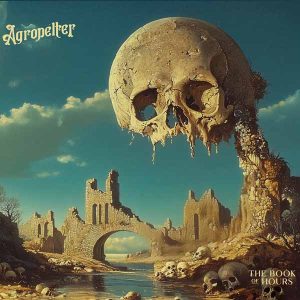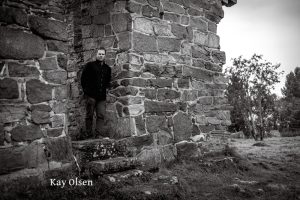Quite why this artist deemed to call himself Agropelter is beyond me. This is based on the fact that an Agropelter is a mythical creature who lives in hollow tree trunks from Maine to Oregon in the USA and preys on passing victims by firing projectiles like wooden splinters and tree branches with significant velocity. The man behind this moniker is Norwegian multi-instrumentalist Kay Olsen many miles from those two American locations. Kay had previously been a member of various metal bands as a guitarist. With this in mind you simply wouldn’t think this after hearing his debut album The Book Of Hours. It has to be said from the outset that the usual comparisons will me made with regards to the musical styles and textures made famous by 70’s Prog luminaries. Kay Olsen has solicited some expert assistance here by recruiting some of the best in the business. Bassist Jonas Reingold (karmakanik / The Flower Kings / Steve Hackett) Mattias Olsson ( White Willow / Anglagard / Molesome) percussion and vintage synthesiser overdubs, Andreas Sjøen (Umpfel / VADE / Sean Ashe) drums. There is also a cast of classical musicians playing strings and woodwind instruments. What makes this album so special in my view is that digital technology for the best part has been side stepped in favour of traditional analogue instruments such as ARP and Mini Moog synthesisers, Hammond L100 organ and Mellotron M400. As well as Progressive rock there is also classical music to be heard in the piano playing throughout the album reminiscent of Rachmaninov, Beethoven et al. No mean feat for a musician previously playing guitar in a metal band.
The album consists of three stand alone tracks and a suite of four pieces representing the title of the album The Book Of Hours. From the very first notes of Flute Of Peril it is clear that much of the piece is based around a cold blustery atmosphere augmented in full by the sound of a thunderstorm and icy wind. Dramatic bass pedals, Mellotron and synthesiser make for a great crescendo to this brief but powerful opener. The delicate flute playing lures the listener into thinking this is basically Prog central! Far from it, with not a second to lose Levator springs into step. Kay Olsen’s guitar playing smoothly through the piece whilst Andreas Sjøen’s powerful drums are solid throughout. Bringing the proceedings to a close here are to mighty tones of pipe organ recorded live at Frogner church situated some 70 metres across the street from Kay Olsen’s house. As the title of the next piece would suggest, Funeral Mound is a mournful affair with some great chorale Mellotron and Jonas Reingold’s sumptuous fretless bass playing create a dark brooding atmosphere whilst drums and percussion played erratically in the background reminded me of Jamie Muir’s eccentric outings many moons ago with King Crimson.
The longest track on the album is The Book Of Hours part 1 at 11:07 minutes and begins with Kay Olsen’s sedate piano playing accompanied by flute soon rescued from it’s tranquillity by a grungy Hammond organ and some great synth playing. Once again the solid drums guide the piece ferociously into an exciting guitar solo with only a slight trace of shredding. The mood and time signature change the pace at five minutes into this stella section of the wider mass. Piano here is almost a classical recital before the return of the Hammond organ and once again some stunning synth playing whilst Jonas Reingold shows off his bass licks before the orchestral grandeur completing this part of the suite. The Book Of Hours part 2 begins with almost jazz inflections as well as a classical vibe and bluesy guitar. Yet again it is the adept synthesiser playing that stands out throughout the piece with the orchestration swelling towards its conclusion. There is definitely more than a Vangelis feel to the piece ending beautifully with piano.
The Book Of Hours part 3 gives out some sinister low frequency sound before the barrage of synthesisers and piano leading to some dramatic Mellotron along with Mini Moog and guitar. As with the previous pieces the drums here drive the music along to another amazing crescendo. For me this piece is one of the highlights of the whole album. The final part of the suite The Book Of Hours part 4 lends its opening to a classical style once again with Kay Olsen playing harpsichord and classical acoustic guitar. However, two minutes into the piece the chorale Mellotron returns backed with a sweet sounding sequencer in tow. Indeed, there is a lot of electronics in the mix and some wicked subsonic tones courtesy of kay’s bass pedals. All in all an intense and uplifting conclusion to a fabulous opus brimming with virtuosity possessing so many elements of what the followers of early classic prog bands enjoy, yet has enough appeal to draw in the younger music fans seeking alternatives to the mainstream musical forms. As with a lot of albums bereft of any lyrical content the premise of the music is left to the listeners personal interpretation. As in days of yore the striking artwork by Dag E-Clausen does conjure up an apocalyptic image in the minds eye. Released in July 2025 The Book Of Hours could well be the most overlooked album of the year and deserves pride of place in anyone’s end of year poll, I know it’s in mine. Kay Olsen has set the bar high for himself as so many bands and artists do. I can’t wait to Hear the next Agropelter album and based on the music throughout this sublime album will be a definite purchase. For anyone like myself who enjoy quality keyboard driven music I would consider The Book Of Hours essential.
The Book Of Hours is available on CD, vinyl and 24bit download at…….
https://agropeltermusic.com/collections/products
https://lasersedge.bandcamp.com/album/the-book-of-hours










